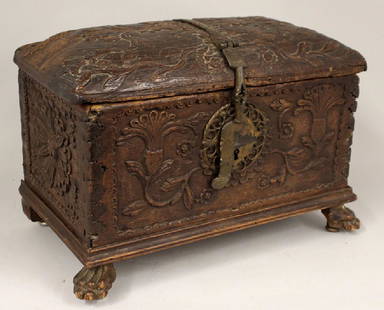
18th C. Spanish Colonial Santo Virgin of Quito
Similar Sale History
View More Items in Sculptures & CarvingsRelated Sculptures & Carvings
More Items in Spanish Colonial Sculptures & Carvings
View MoreRecommended Art
View More




Item Details
Description
**First Time At Auction**
Latin America, Spanish Colonial, Ecuador, Quito, ca. 18th century CE. A truly striking wooden representation of the Virgin of Quito or the Woman of the Apocalypse with a serpent and crescent moon. The wood carving is elaborate, with large repousse silver wings and 12-starred crown. Worshippers have draped her neck with silver chains and rosary beads. Mary, with kind, well-painted face and brown glass eyes, is posed looking downward, with her arms out to one side as if casting something away; she wears richly decorated robes and a dark blue and red garment draped over them in addition to her crown and wings. She stands atop the crescent moon as it rises from a patch of swirling cloud. Below her feet is a serpent whose head emerges in a fierce yowl; his visible tail wraps around one side of the moon. This is the serpent of Genesis and Revelation, a manifestation of Satan. Size: 9.25" L x 14.1" W x 20.5" H (23.5 cm x 35.8 cm x 52.1 cm); 21.25" H (54 cm) on included custom stand.
The Virgin of Quito (Spanish, La Virgen de Quito) - also known as the Virgin of the Apocalypse, Winged Virgin of Quito, Dancing Madonna, and Legarda's Virgin - is a wooden sculpture by the Quiteno artist Bernardo de Legarda (ca. 1700-1773) which has become the most representative example of the Quito School of art, developed in the Ecuadorian capital during the Spanish colonial era. This particular Virgin became a popular cult image which is still venerated - via innumerable models - throughout the northern Andes.
The composition is derived from the biblical description of the Woman of the Apocalypse. As described in the Revelation of Saint John (12:1-2), the woman was "clothed in the sun." Also in accordance with the text, she has a crescent moon under her feet and a silver diadem bearing 12 stars is on her head. After battling a dragon - i.e. Satan - she has trampled and subdued the beast with a heavy silver chain which she holds loosely in her open hands. She has been given silver wings for escape. Probably influenced by 16th century European prints, such as that of Albrecht Durer's Apocalypse series, the "dancing" Virgin seems to float and gestures with open hands to her right amid an abundance of flouncing folds conveying both flight and ecstasy.
Though the tradition of polychrome wood sculpture originated in Europe, some of the finest practitioners were in Quito (the seat of the Audiencia de Quito, in the viceroyalty of Peru), which became internationally known for its exquisitely-carved wooden sculptures that were exported to other areas of colonial Latin America and to Europe. Unfortunately, only a few sculptors have been documented - most notably Bernardo Legarda (c. 1700-1773) and Manuel Chili (more widely known as Caspicara, c. 1723-1796). The profession was dominated by Indigenous and mestizo artist within the framework of family-run workshops and involved the work of many craftsmen, such as carvers, polychromers, and silversmiths.
By the 1700s, Quito sculpture had developed a highly distinctive and largely self-referential style. Artists produced hundreds of images of different saints and advocations. The works are typically distinguished by the figures' smooth and youthful features, rosy cheeks, lifelike eyes made of glass, pursed red lips, and plump, shiny flesh (encarnaciones). Decorated with exuberant estofados (pictorial emulations of fine fabrics), most works served a predominantly private devotional purpose in homes and convents.
The most identifiable feature of Quito style was the employment of lead masks (mascarillas de plomo) for the face, as seen in this example - a method that enabled artists to employ the same mold for various figures. This technique was likely adopted in response to the high demand for images, which by this time were produced in quasi-industrial quantities.
A comparable sculpture of the Virgin of Quito of a more petite scale (13.75 inches) hammered $50,000 at Christie's New York on November 21, 2013 (lot 155, "Latin American Art" Live Auction 15581.
Cf. the Metropolitan Museum of Art (64.164.236a, b) and the Brooklyn Museum (58.37).
Provenance: private Graftan, Wisconsin, USA collection, acquired via Artemis Gallery, Louisville, Colorado, USA, April 12, 2017, lot 136; ex-Francis & Lilly Robicsek Collection, Charlotte, North Carolina, USA
All items legal to buy/sell under U.S. Statute covering cultural patrimony Code 2600, CHAPTER 14, and are guaranteed to be as described or your money back.
A Certificate of Authenticity will accompany all winning bids.
We ship worldwide to most countries and handle all shipping in-house for your convenience.
#184280
Latin America, Spanish Colonial, Ecuador, Quito, ca. 18th century CE. A truly striking wooden representation of the Virgin of Quito or the Woman of the Apocalypse with a serpent and crescent moon. The wood carving is elaborate, with large repousse silver wings and 12-starred crown. Worshippers have draped her neck with silver chains and rosary beads. Mary, with kind, well-painted face and brown glass eyes, is posed looking downward, with her arms out to one side as if casting something away; she wears richly decorated robes and a dark blue and red garment draped over them in addition to her crown and wings. She stands atop the crescent moon as it rises from a patch of swirling cloud. Below her feet is a serpent whose head emerges in a fierce yowl; his visible tail wraps around one side of the moon. This is the serpent of Genesis and Revelation, a manifestation of Satan. Size: 9.25" L x 14.1" W x 20.5" H (23.5 cm x 35.8 cm x 52.1 cm); 21.25" H (54 cm) on included custom stand.
The Virgin of Quito (Spanish, La Virgen de Quito) - also known as the Virgin of the Apocalypse, Winged Virgin of Quito, Dancing Madonna, and Legarda's Virgin - is a wooden sculpture by the Quiteno artist Bernardo de Legarda (ca. 1700-1773) which has become the most representative example of the Quito School of art, developed in the Ecuadorian capital during the Spanish colonial era. This particular Virgin became a popular cult image which is still venerated - via innumerable models - throughout the northern Andes.
The composition is derived from the biblical description of the Woman of the Apocalypse. As described in the Revelation of Saint John (12:1-2), the woman was "clothed in the sun." Also in accordance with the text, she has a crescent moon under her feet and a silver diadem bearing 12 stars is on her head. After battling a dragon - i.e. Satan - she has trampled and subdued the beast with a heavy silver chain which she holds loosely in her open hands. She has been given silver wings for escape. Probably influenced by 16th century European prints, such as that of Albrecht Durer's Apocalypse series, the "dancing" Virgin seems to float and gestures with open hands to her right amid an abundance of flouncing folds conveying both flight and ecstasy.
Though the tradition of polychrome wood sculpture originated in Europe, some of the finest practitioners were in Quito (the seat of the Audiencia de Quito, in the viceroyalty of Peru), which became internationally known for its exquisitely-carved wooden sculptures that were exported to other areas of colonial Latin America and to Europe. Unfortunately, only a few sculptors have been documented - most notably Bernardo Legarda (c. 1700-1773) and Manuel Chili (more widely known as Caspicara, c. 1723-1796). The profession was dominated by Indigenous and mestizo artist within the framework of family-run workshops and involved the work of many craftsmen, such as carvers, polychromers, and silversmiths.
By the 1700s, Quito sculpture had developed a highly distinctive and largely self-referential style. Artists produced hundreds of images of different saints and advocations. The works are typically distinguished by the figures' smooth and youthful features, rosy cheeks, lifelike eyes made of glass, pursed red lips, and plump, shiny flesh (encarnaciones). Decorated with exuberant estofados (pictorial emulations of fine fabrics), most works served a predominantly private devotional purpose in homes and convents.
The most identifiable feature of Quito style was the employment of lead masks (mascarillas de plomo) for the face, as seen in this example - a method that enabled artists to employ the same mold for various figures. This technique was likely adopted in response to the high demand for images, which by this time were produced in quasi-industrial quantities.
A comparable sculpture of the Virgin of Quito of a more petite scale (13.75 inches) hammered $50,000 at Christie's New York on November 21, 2013 (lot 155, "Latin American Art" Live Auction 15581.
Cf. the Metropolitan Museum of Art (64.164.236a, b) and the Brooklyn Museum (58.37).
Provenance: private Graftan, Wisconsin, USA collection, acquired via Artemis Gallery, Louisville, Colorado, USA, April 12, 2017, lot 136; ex-Francis & Lilly Robicsek Collection, Charlotte, North Carolina, USA
All items legal to buy/sell under U.S. Statute covering cultural patrimony Code 2600, CHAPTER 14, and are guaranteed to be as described or your money back.
A Certificate of Authenticity will accompany all winning bids.
We ship worldwide to most countries and handle all shipping in-house for your convenience.
#184280
Condition
Missing proper left ear and fang of serpent, small finger of Mary's right hand, and 2 small areas on periphery of base. Large fissure with infill and some restoration and a few fingers have been professionally reattached. Right hand is loose and noticeable fissure around where lead face was attached. Some chipping to gesso and pigments as well as nicks and abrasions to surface as shown. Glass eyes intact and beautiful craquelure to face and neck. Rich patina throughout. Set on custom wooden stand.
Buyer's Premium
- 27.5%
18th C. Spanish Colonial Santo Virgin of Quito
Estimate $6,000 - $9,000
17 bidders are watching this item.
Shipping & Pickup Options
Item located in Louisville, CO, usShip with LiveAuctioneers
Local Pickup Available
Arrange Your Own Shipping
Payment
Accepts seamless payments through LiveAuctioneers

Auction Curated By

Owner/Executive Director, Antiquities & Pre-Columbian Art

PhD. Art History, Director, Fine & Visual Arts
TOP



































































